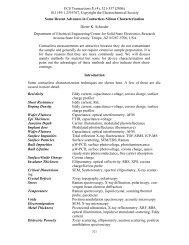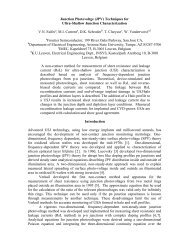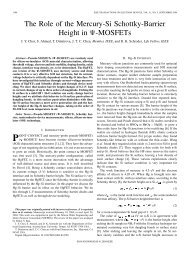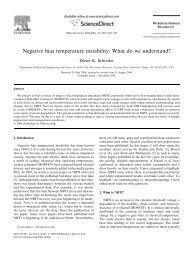Surface voltage and surface photovoltage - Dieter Schroder ...
Surface voltage and surface photovoltage - Dieter Schroder ...
Surface voltage and surface photovoltage - Dieter Schroder ...
You also want an ePaper? Increase the reach of your titles
YUMPU automatically turns print PDFs into web optimized ePapers that Google loves.
D K <strong>Schroder</strong><br />
(a)<br />
L n (µm)<br />
L n (µm)<br />
5.2. Lifetime<br />
Two types of lifetime are measured in Si wafers: the<br />
recombination lifetime, τ r , <strong>and</strong> the generation lifetime, τ g [29].<br />
As the name implies, the recombination lifetime characterizes<br />
the recombination of ehps, while the generation lifetime<br />
characterizes the generation of ehps. The recombination<br />
lifetime is determined by depositing sufficient charge on an<br />
oxidized wafer to invert the semiconductor <strong>surface</strong> forming a<br />
field-induced np junction in a p-type substrate. A brief light<br />
pulse forward biases this np junction, injecting excess carriers<br />
that subsequently recombine. The resulting time-dependent<br />
<strong>surface</strong> <strong>voltage</strong> is monitored with a Kelvin probe. This method<br />
is very similar to the open-circuit <strong>voltage</strong> decay technique. τ r is<br />
determined from the equation [37]<br />
τ r =<br />
kT/q<br />
dV p /dt . (30)<br />
(b)<br />
N Fe (x10 11 cm -3 )<br />
(c)<br />
Figure 15. Diffusion length maps (a) before, (b) after Fe–B pair<br />
dissociation; (c) iron density map (in units of 10 11 cm −3 ). Courtesy<br />
of P Edelman <strong>and</strong> J Lagowski, Semiconductor Diagnostics, Inc.<br />
those of Fe–B. By measuring the diffusion length before (L ni )<br />
<strong>and</strong> after (L nf ) Fe–B pair dissociation, the iron density N Fe is<br />
obtained from the expression [34]<br />
N Fe = 1.05 × 10 16 ( 1<br />
L 2 nf<br />
− 1 )<br />
L 2 cm −3 (29)<br />
ni<br />
with diffusion lengths in units of µm. The Fe i <strong>and</strong> Fe–B<br />
diffusion lengths as a function of Fe density are shown in<br />
figure 14 [35]. This large difference in diffusion length<br />
between Fe i <strong>and</strong> Fe–B only pertains at low injection levels<br />
<strong>and</strong> disappears at medium to high injection levels. Maps of<br />
diffusion lengths before <strong>and</strong> after Fe–B pair dissociation <strong>and</strong><br />
the resultant Fe density are shown in figure 15. Metals rarely<br />
pair with impurities in n-type Si, although Cu does form such<br />
pairs [36].<br />
The generation lifetime is determined by depositing a charge<br />
pulse driving the corona–oxide–semiconductor (COS) device<br />
into deep depletion. Electron–hole pairs are subsequently<br />
generated <strong>and</strong> the resulting <strong>voltage</strong> transient is monitored<br />
with a contactless Kelvin probe [23]. These two methods<br />
were recently used to characterize both epitaxial films <strong>and</strong><br />
their substrates [38]. The epitaxial layer is characterized<br />
through τ g measurements, with the thermal carrier generation<br />
confined to the charge-induced space-charge region, which is<br />
typically of the order of 1 µm below the semiconductor <strong>surface</strong>.<br />
The recombination lifetime, on the other h<strong>and</strong>, characterizes<br />
a depth determined by the minority carrier diffusion<br />
length. Figure 16 illustrates corona-induced generation <strong>and</strong><br />
recombination lifetime measurements of n-epitaxial layers on<br />
n-substrates. Figure 16(a) shows the results for both ‘good’<br />
layer <strong>and</strong> ‘good’ substrate with τ g ≈ 4 ms <strong>and</strong> τ r ≈ 300 µs.<br />
Figure 16(b) shows a ‘good’ epitaxial layer (τ g ≈ 3ms),<br />
but the substrate is contaminated, reducing the recombination<br />
lifetime to about 50 µs. While recombination lifetime<br />
measurements can be made without corona charge, using<br />
conventional <strong>surface</strong> photo<strong>voltage</strong> or photoconductance decay<br />
measurements, contactless generation lifetime measurements<br />
require corona charge.<br />
5.3. Charge<br />
The <strong>surface</strong> <strong>voltage</strong> dependence on <strong>surface</strong> charge lends itself<br />
to measurements of charge in the insulator on a semiconductor<br />
wafer or charge on the wafer. This charge can be oxide charge,<br />
interface trapped charge plasma damage charge, or other<br />
charge. Let us illustrate this by considering the mobile charge<br />
density Q m in an oxidized wafer [39]. Such mobile charge<br />
in silicon technology is most commonly sodium, originating<br />
from such sources as humans, chemicals, equipment etc.<br />
Other possible mobile charges are potassium, associated<br />
with chemical polishing compounds, <strong>and</strong> lithium, which can<br />
originate from pump oils.<br />
One way to measure such a mobile charge is to<br />
combine SV measurements with corona charge techniques<br />
by depositing corona charge on an oxidized semiconductor<br />
<strong>surface</strong>. First deposit positive corona charge, then heat the<br />
wafer to a moderate temperature of around 200 ◦ Cforafew<br />
R24








